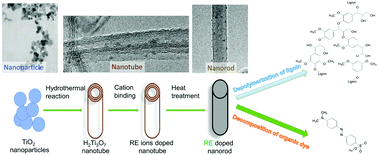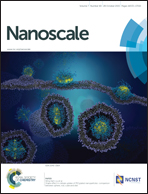Synthesis of rare earth doped TiO2 nanorods as photocatalysts for lignin degradation†
Abstract
A two-step process is developed to synthesize rare earth doped titania nanorods (RE–TiO2 NRs) as photocatalysts for efficient degradation of lignin under simulated sunlight irradiation. In this approach, protonated titanate nanotubes with layered structures were first prepared by a hydrothermal approach, and rare earth metal ions were subsequently bound to the negatively charged surface of the synthesized titanate via electrostatic incorporation. The as-synthesized RE–TiO2 NRs after calcination generally showed much higher photocatalytic efficiencies than those of undoped TiO2 NRs or the commercial P25 TiO2 photocatalyst. Using methyl orange (MO) as a probing molecule, we demonstrate that Eu–TiO2 NRs are among the best for degrading MO, with an observed rate constant of 4.2 × 10−3 s−1. The La3+, Sm3+, Eu3+ and Er3+ doped TiO2 NRs also showed higher photocatalytic efficiencies in degrading MO than the commercial P25 TiO2. We further demonstrate that lignin can be photodegraded effectively and rapidly at room temperature under simulated sunlight through two reaction routes, which could be important in controlling ways of lignin depolymerization or the formation of reaction products.


 Please wait while we load your content...
Please wait while we load your content...